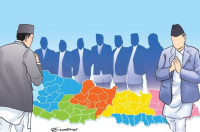Columns
Patriarchy and citizenship
Conspiracy theories flowed seamlessly from Panchayat-era scholars to politicians.
Pramod Mishra
Many states in the United States, including Illinois (where I reside), have opened for business after about three months of stay-at-home orders. But these states, many among them located in the south, whose governments refused to issue lockdown restrictions in the name of freedom, and were either slow in closing or remained open, have seen a sudden rise in Covid-19 cases. But even in states like Illinois, not everybody has followed the CDC (Centres for Disease Control and Prevention) guidelines for wearing a mask, washing the hands frequently and maintaining social distancing.
I have spoken to a few of these obstinate people and have come to know the reasons why they ignored CDC guidelines. They all believe in conspiracy theories. They claim that they have done 'research' and that’s how they came to the conclusion about masks and Covid-19 deaths. They don’t believe in the death statistics resulting from the virus, and think that this is a big conspiracy hatched by the elite or the liberals or somebody. They believe that this is a conspiracy against America and Americans to take away their freedom. They also believe that Bill Gates with his billions is using his money to devise a vaccine that will be used for mind control, enabling him to rule over Americans. The conspiracy theories don’t end here.
Regime of surveillance
Now, if you have read Israeli intellectual Yuval Noah Harari’s piece in the Financial Times on governments’ use of apps or other forms of technology to trace and track people and induce or compel them to follow government guidelines for health safety during the virus crisis, you know that he says that once this pandemic is over, governments can continue to use such surveillance technology to measure people’s emotions toward one party or leader or another and thereby manipulate their emotions and, in the case of dictatorships, reward blind followers and punish 'enemies' of the regime. This regime of surveillance that Harari talks about is not his theoretical innovation. French philosopher Michel Foucault devoted his entire stellar academic career to chart the rise of the surveillance regime with the rise of modernity. And many academic disciplines have based their new directions on Foucault’s theories.
So, should one, then, say that anti-mask, anti-vaccine conspiracy theorists and their believers are as correct about surveillance as Foucault or Harari? They certainly are not. But correct or not, they have been quite persuasive with a large group of Americans.
Similarly, Nepal’s citizenship debate has always remained a contentious issue based on the foundation of conspiracy theories about India’s population expansion in Nepal since king Mahendra’s coup in 1960, his Panchayat system imposing discriminatory citizenship laws based on one dress, one language nationalism.
Political leaders from the southern plains, called Madhesis, always formed one side of the debate, demanding flexible provisions for citizenship, given the Nepal-India cross-border cultural exchange. On the other hand, the Panchayat system—steeped in the Nepali language and Nepali dress (both made-up categories from hill castes to represent their ethnicity) nationalism and 'manned' (for these were almost all men) by mostly hill high castes—spread this patriarchal, monolingual, monocultural nationalism through the state structure and their practices at home, in their offices and in the public domain through Radio Nepal and the school curriculum from preschool through grade 10. The history and civics curricula beyond grade 10 through Master’s degrees were not very different.
This structural, ideological and practical assault on the country’s historically existing diversity had a very astute gender dimension. At home within families, this gender discrimination manifested itself in the unequal treatment between sons and daughters, between daughters and daughters-in-law, and between husbands and wives; but in the public domain, it emerged in the form of identifying the Nepali nation’s other, the Madhesis. While gender discrimination at home had its sources in caste Hindu ‘sanskar’ as laid out in the shastras (epics, Puranas and Manusmriti) as interpreted in the rote-learning tradition of Sanskrit schools by Brahmin priests and inherited from Muluki Ain of 1854, the state’s public discrimination of its other had its sources in the conspiracy theories concocted by Nepal’s newly minted scholars like Harka Gurung and others in the newly established centre of research in Kirtipur.
When persons like Gurung went down to the plains for field studies, they brought with them their acculturation and ideology of the hills, and were shocked that Nepal’s southern plains had such an open border with India that people from either side could come and go as they please. They could see no difference in language, dress, looks and culture between the Indian and the Nepali sides of the border, creating a crisis of Nepali nationalism in their minds.
That shock of the border gave rise in their minds all kinds of conspiracy theories about India’s population design on Nepal. That’s why, every time citizenship certificates are distributed, there is always a conspiracy theory attached to the act that inflates the number of beneficiaries from 100,000 to four million. That’s why, borrowed from these conspiracy theory scholars, many politicians, especially of the left parties, champion these conspiracy theories about Nepal being in danger of turning into Fiji.
Unlike the sharper distinction made by scholars of the surveillance regime of modernity like Harari and Foucault, conspiracy theorists’ assumptions are not based on hard evidence and vetted conclusions. But in Nepal’s case, the flow of conspiracy theories from Panchayat-era scholars to politicians became seamless. And leading left politicians of the Nepal Communist Party and their followers still champion those conspiracies about foreigners across the border from India overrunning Nepal. And the Nepali youth, raised on anti-India ideas (and India, too, has a role to play here, no doubt), readily buy into these conspiracies.
Smoke and mirror
Thankfully, the media scene has improved over the years, and a band of educated intellectuals and activists have been able to tear through these conspiracy theories and come out in the open to oppose the government’s gender discriminatory citizenship bill. The educated Nepali women of today, even though born and raised in the patriarchal household of the Panchayat system, have been educated by the marketplace of crosscurrent ideas in the media in the past quarter-century, and have developed their own critical thinking skills to see through the smoke and mirror of conspiracy theorists. And they have said, enough is enough, ‘You can’t fool us to accept second class citizen status by spouting conspiracy theories of nationalism’. Alas, that can’t be said about the female members of Parliament of the ruling party.
Let’s hope that the competition of ideas in the marketplace of the Nepali media thrives, and the new generation of Nepali young men and women cultivate critical thinking skills. And conspiracy theorists find themselves eventually laughed at and sidelined. Until then, let’s continue our task of educating the public through reliable evidence-based knowledge and its fact-based interpretation.




 6.12°C Kathmandu
6.12°C Kathmandu















